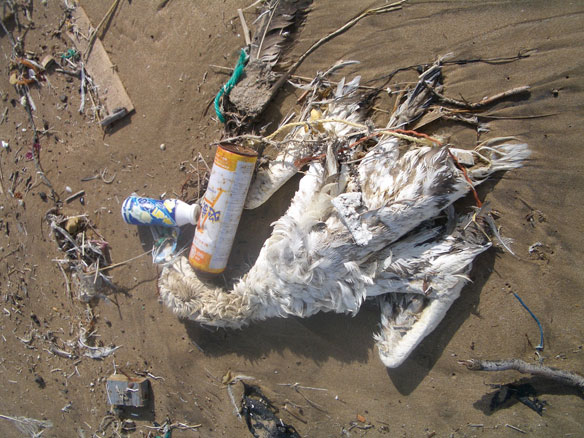
“When plastic ingestion occurs, it blocks the digestive tract, gets lodged in animals windpipes cutting airflow causing suffocation, or fills the stomach, resulting in malnutrition, starvation and potentially death. Indeed, it is found that debris often accumulates in the animals’ gut and give a false sense of fullness, causing the animal to stop eating and slowly starve to death.” —Captions and Photo: © SAF — Coastal Care
Excerpts;
Marine researchers spotted a dolphin suffocating in a plastic bag last week in Watamu, Kenya.
The incident, the first to be witnessed there, has raised concern on the safety of the millions of sea animals in the Indian Ocean waters due to the increased cases of plastic waste.
Read Full Article; The Star Kenya (01-24-2017)
Sea Turtles Face Plastic Pollution Peril, University of Exeter (10-09-2015)
A new global review that set out to investigate the hazards of marine plastic pollution has warned that all seven species of marine turtles can ingest or become entangled in the discarded debris that currently litters the oceans, and nesting beaches…
Global Impact of Debris on Marine Life Studied, (02-19-2015)
Nearly 700 species of marine animal have been recorded as having encountered humanmade debris such as plastic and glass according to the most comprehensive impact study in more than a decade…
The Plastic Found In a Single Turtle’s Stomach, Independent UK (03-24-2011)
Death by Plastic: Is Ocean Plastic Garbage Killing Whales?, Independent UK
90 Percent of Seabirds Have Plastic in Their Stomachs, Newsweek (09-01-2015)
U.S. polluting ocean with trash at alarming rate, CBS News
20 countries are responsible for more than 80 percent of the plastic going into the ocean annually. China is the worst, with about 2.4 million tons. The United States is number 20, responsible for about 750,000 pounds…
Biodegradable Plastics Are Not the Answer to Reducing Marine Litter, UN News Center (11-23-2015)
Widespread adoption of products labelled ‘biodegradable’ will not significantly decrease the volume of plastic entering the ocean or the physical and chemical risks that plastics pose to marine environment, concluded a UN report released today…
All Human-Made Objects on Earth Amount to 30 Trillion Tons; LiveScience (12-05-2016)
Plastic Pollution / When The Mermaids Cry: The Great Plastic Tide, Coastal Care
“The unprecedented plastic waste tide plaguing our oceans and shores, can become as limited as our chosen relationship with plastics, which involves a dramatic behavioral change on our part…”

A study reports that as high as 50% of camel deaths are caused by plastic bags’s ingestion…and this was in 1997…— Smeadvisor
“For more than 50 years, global production and consumption of plastics have continued to rise. An estimated 300 million tons of plastics were produced in 2015, confirming and upward trend over the past years, according to a new report by the World Economics Forum, released at Davos in January 2016.
Plastic is versatile, lightweight, flexible, moisture resistant, strong, and relatively inexpensive. Those are the attractive qualities that lead us, around the world, to such a voracious appetite and over-consumption of plastic goods. However, durable and very slow to degrade, plastic materials that are used in the production of so many products all, ultimately, become waste with staying power.
Our tremendous attraction to plastic, coupled with an undeniable behavioral propensity of increasingly over-consuming, discarding, littering and thus polluting, has become a combination of lethal nature…”
” —Captions and Photo: © SAF — Coastal Care








